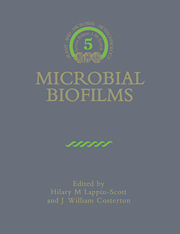Book contents
- Frontmatter
- Contents
- List of Contributors
- Series Preface
- Introduction to Microbial Biofilms
- Part I Structure, Physiology and Ecology of Biofilms
- Part II Biofilms and Inert Surfaces
- Part III Biofilms on the Surfaces of Living Cells
- 12 The Rhizosphere as a Biofilm
- 13 Biofilms of the Ruminant Digestive Tract
- 14 The Immune Response to Bacterial Biofilms
- 15 Bacterial Biofilms in the Biliary System
- 16 Biofilm Associated Urinary Tract Infections
- 17 The Role of the Urogenital Flora in Probiotics
- 18 Dental Plaque
- Index
16 - Biofilm Associated Urinary Tract Infections
Published online by Cambridge University Press: 24 November 2009
- Frontmatter
- Contents
- List of Contributors
- Series Preface
- Introduction to Microbial Biofilms
- Part I Structure, Physiology and Ecology of Biofilms
- Part II Biofilms and Inert Surfaces
- Part III Biofilms on the Surfaces of Living Cells
- 12 The Rhizosphere as a Biofilm
- 13 Biofilms of the Ruminant Digestive Tract
- 14 The Immune Response to Bacterial Biofilms
- 15 Bacterial Biofilms in the Biliary System
- 16 Biofilm Associated Urinary Tract Infections
- 17 The Role of the Urogenital Flora in Probiotics
- 18 Dental Plaque
- Index
Summary
Introduction
Urinary tract infections (UTI) of the lower urinary tract are a common problem causing significant morbidity in females and males (Nickel 1990). Most of the causal organisms are Gram negative bacilli such as Escherichia coli and Proteus mirabilis, or Gram positive Enterococcus and Streptococcus spp., which have their reservoir in the gastrointestinal tract. The other major source of UTI pathogens is direct transmission through sexual activity. These organisms first colonize the introitus and the periurethral area before entering the bladder or prostate. There is an indigenous population of Gram positive, acid producing lactobacilli in this environment which under normal circumstances appears to enhance the urinary defence mechanisms and inhibit the successful progression of the enterics into the urethra and bladder (Chan et al. 1985; Reid et al. 1987, 1990a). When the balance between enteric uropathogens and host defences is upset, uropathogens are able to ascend through the urethra into the bladder, the prostate (in males) and less often into the kidneys where they colonize and cause infection. Usually only the bladder is infected giving rise to simple, uncomplicated acute cystitis. This condition is readily treated by several standard antibiotic regimes (Nickel 1990). Problems arise when this infection spreads from the bladder into other organs such as the kidneys (pyelonephritis) or prostate (prostatitis), or induces the formation of calculi (struvite urolithiasis: McLean et al. 1988, 1992). In these cases, significant tissue damage may occur, possibly causing permanent damage to renal function, which can be life threatening.
- Type
- Chapter
- Information
- Microbial Biofilms , pp. 261 - 273Publisher: Cambridge University PressPrint publication year: 1995
- 12
- Cited by

